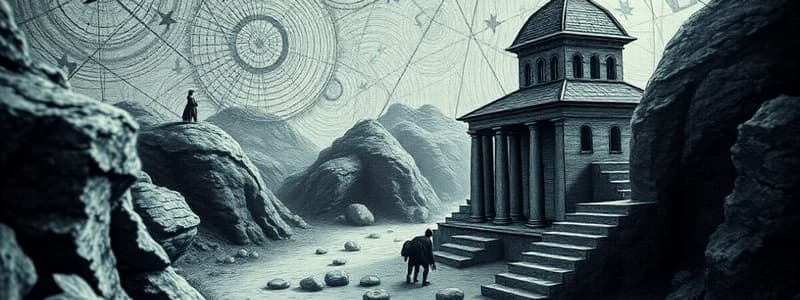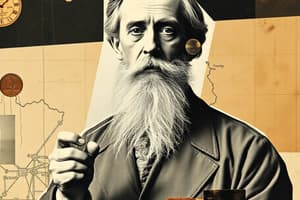Podcast
Questions and Answers
How did Robert Hooke disseminate his law of elasticity initially?
How did Robert Hooke disseminate his law of elasticity initially?
- As an anagram, to establish priority while obscuring the full details. (correct)
- Orally, at a Royal Society meeting, with a full explanation.
- Through a detailed mathematical treatise published in *Philosophical Transactions*.
- In personal correspondence with Isaac Newton, seeking his validation.
What was the significance of Hooke's Micrographia beyond its detailed illustrations?
What was the significance of Hooke's Micrographia beyond its detailed illustrations?
- It established a new standard for scientific observation using improved microscopy. (correct)
- It popularized the use of Latin nomenclature in biological classification.
- It was the first book to document fossils and propose a theory of evolution.
- It outlined a heliocentric model of the solar system based on microscopic observations.
In what capacity did Robert Hooke contribute to the rebuilding of London after the Great Fire of 1666?
In what capacity did Robert Hooke contribute to the rebuilding of London after the Great Fire of 1666?
- He invented new fire-resistant building materials that were widely adopted.
- He personally financed the reconstruction of several prominent churches.
- He served as the chief surveyor, helping to redesign the city's layout. (correct)
- He led a team of cartographers to redraw the city's maps from memory.
What distinguished Hooke's early education from that of many other prominent scientists of his time?
What distinguished Hooke's early education from that of many other prominent scientists of his time?
How did Hooke's work as an assistant to Robert Boyle influence his scientific development?
How did Hooke's work as an assistant to Robert Boyle influence his scientific development?
What is the most precise, formal mathematical representation of Hooke's Law?
What is the most precise, formal mathematical representation of Hooke's Law?
What was the social impact of Hooke publishing Micrographia?
What was the social impact of Hooke publishing Micrographia?
Which area did Hooke NOT contribute to?
Which area did Hooke NOT contribute to?
At what age did Hooke begin studying at Oxford University?
At what age did Hooke begin studying at Oxford University?
What type of scholarship did Hooke obtain when studying at Oxford University?
What type of scholarship did Hooke obtain when studying at Oxford University?
Robert Hooke's quote emphasizes the significance of telescopes and microscopes in expanding human knowledge. What is the underlying philosophical implication of this expansion?
Robert Hooke's quote emphasizes the significance of telescopes and microscopes in expanding human knowledge. What is the underlying philosophical implication of this expansion?
Considering the historical context of Hooke's time, what was the most revolutionary aspect of his assertion that a 'new visible world' was being discovered?
Considering the historical context of Hooke's time, what was the most revolutionary aspect of his assertion that a 'new visible world' was being discovered?
How might Hooke's observations and the publication of Micrographia have influenced the subsequent development of the scientific method?
How might Hooke's observations and the publication of Micrographia have influenced the subsequent development of the scientific method?
In what way does Hooke's statement anticipate the paradigm shift from a predominantly macroscopic understanding of the world to one that also incorporates the microscopic?
In what way does Hooke's statement anticipate the paradigm shift from a predominantly macroscopic understanding of the world to one that also incorporates the microscopic?
What is a valid critique of Hooke's enthusiastic embrace of microscopes and telescopes as tools for understanding the world?
What is a valid critique of Hooke's enthusiastic embrace of microscopes and telescopes as tools for understanding the world?
How does Hooke's emphasis on the 'new visible world' relate to the broader concept of scientific revolution?
How does Hooke's emphasis on the 'new visible world' relate to the broader concept of scientific revolution?
Assuming Hooke could observe scientific progress today, how would he likely view the modern use of advanced imaging technologies (e.g., electron microscopy, MRI) in scientific research?
Assuming Hooke could observe scientific progress today, how would he likely view the modern use of advanced imaging technologies (e.g., electron microscopy, MRI) in scientific research?
Which advancement was crucial to Hooke's ability to observe detailed structures under his microscope?
Which advancement was crucial to Hooke's ability to observe detailed structures under his microscope?
What was the most significant contribution of Antonie van Leeuwenhoek to the field of microbiology?
What was the most significant contribution of Antonie van Leeuwenhoek to the field of microbiology?
How did Leeuwenhoek disseminate his scientific findings to the broader scientific community?
How did Leeuwenhoek disseminate his scientific findings to the broader scientific community?
What probable factor contributed most to the limited advancement of microscopy after Leeuwenhoek's discoveries?
What probable factor contributed most to the limited advancement of microscopy after Leeuwenhoek's discoveries?
What was the primary distinction between Hooke's and Leeuwenhoek's microscopic investigations?
What was the primary distinction between Hooke's and Leeuwenhoek's microscopic investigations?
How might the limitations of Leeuwenhoek's single-lens microscopes have paradoxically contributed to his discoveries?
How might the limitations of Leeuwenhoek's single-lens microscopes have paradoxically contributed to his discoveries?
What can be inferred from Leeuwenhoek holding the Curator of Experiments position for over 40 years?
What can be inferred from Leeuwenhoek holding the Curator of Experiments position for over 40 years?
Considering the context of scientific innovation in the 17th century, what element most likely enabled Hooke and Leeuwenhoek to make such significant advancements in microscopy?
Considering the context of scientific innovation in the 17th century, what element most likely enabled Hooke and Leeuwenhoek to make such significant advancements in microscopy?
How did the design of Hooke's microscope specifically address the challenges of observing microscopic specimens?
How did the design of Hooke's microscope specifically address the challenges of observing microscopic specimens?
What advantage did Leeuwenhoek's single-lens microscope design have over Hooke's compound microscope?
What advantage did Leeuwenhoek's single-lens microscope design have over Hooke's compound microscope?
Which of the following reflects Hooke's PRIMARY role within the Royal Society during his tenure?
Which of the following reflects Hooke's PRIMARY role within the Royal Society during his tenure?
What was the MOST significant impact of Hooke's invention of the balance spring on timekeeping technology?
What was the MOST significant impact of Hooke's invention of the balance spring on timekeeping technology?
Which statement BEST describes the division of labor and recognition between Hooke and Christopher Wren in the reconstruction of London after the Great Fire?
Which statement BEST describes the division of labor and recognition between Hooke and Christopher Wren in the reconstruction of London after the Great Fire?
How did Hooke's microscope design PRIMARILY enhance the study of microscopic organisms compared to earlier models?
How did Hooke's microscope design PRIMARILY enhance the study of microscopic organisms compared to earlier models?
In the context of Hooke's collaboration with Boyle, what distinguishes Hooke's contribution beyond mere assistance in constructing the air pump?
In the context of Hooke's collaboration with Boyle, what distinguishes Hooke's contribution beyond mere assistance in constructing the air pump?
What was the MOST enduring impact of Hooke's Micrographia on the field of biology?
What was the MOST enduring impact of Hooke's Micrographia on the field of biology?
How did Hooke's understanding of elasticity, formalized in Hooke's Law ($tension \propto force$), directly contribute to advancements in clockmaking?
How did Hooke's understanding of elasticity, formalized in Hooke's Law ($tension \propto force$), directly contribute to advancements in clockmaking?
Which aspect of Hooke's scientific approach is BEST exemplified by his diverse activities as Curator of Experiments?
Which aspect of Hooke's scientific approach is BEST exemplified by his diverse activities as Curator of Experiments?
How did Hooke's improvements to the pendulum clock, specifically the anchor escapement mechanism, enhance its performance?
How did Hooke's improvements to the pendulum clock, specifically the anchor escapement mechanism, enhance its performance?
What was the MOST original and transformative aspect of Hooke's contributions to the study of microscopy?
What was the MOST original and transformative aspect of Hooke's contributions to the study of microscopy?
Flashcards
Robert Hooke
Robert Hooke
A 17th-century British scientist known for his contributions to physics, biology, and architecture.
Law of Elasticity
Law of Elasticity
States that the extension or compression of a spring is proportional to the force applied.
Micrographia
Micrographia
A book published by Hooke in 1665 that used an improved microscope for scientific exploration.
London Redesign
London Redesign
Signup and view all the flashcards
Boyle's Assistant
Boyle's Assistant
Signup and view all the flashcards
Sporadic Education
Sporadic Education
Signup and view all the flashcards
Oxford University
Oxford University
Signup and view all the flashcards
Hooke's Law
Hooke's Law
Signup and view all the flashcards
Inventor
Inventor
Signup and view all the flashcards
Anatomical Drawings
Anatomical Drawings
Signup and view all the flashcards
Boyle's Law
Boyle's Law
Signup and view all the flashcards
Air Pump
Air Pump
Signup and view all the flashcards
Anchor Escapement
Anchor Escapement
Signup and view all the flashcards
Curator of Experiments
Curator of Experiments
Signup and view all the flashcards
Royal Society
Royal Society
Signup and view all the flashcards
Compound Microscope
Compound Microscope
Signup and view all the flashcards
Great Fire of London
Great Fire of London
Signup and view all the flashcards
Hooke's Compound Microscope
Hooke's Compound Microscope
Signup and view all the flashcards
Antonie van Leeuwenhoek
Antonie van Leeuwenhoek
Signup and view all the flashcards
Single-lens Microscope
Single-lens Microscope
Signup and view all the flashcards
Animalcules
Animalcules
Signup and view all the flashcards
Flea Drawing in Micrographia
Flea Drawing in Micrographia
Signup and view all the flashcards
Bacteria Observation
Bacteria Observation
Signup and view all the flashcards
Microscope Magnification
Microscope Magnification
Signup and view all the flashcards
Lens-making Secret
Lens-making Secret
Signup and view all the flashcards
Royal Society Membership
Royal Society Membership
Signup and view all the flashcards
Telescopes
Telescopes
Signup and view all the flashcards
Microscopes
Microscopes
Signup and view all the flashcards
New Visible World
New Visible World
Signup and view all the flashcards
Robert Hooke's Observation
Robert Hooke's Observation
Signup and view all the flashcards
Micrographia's Impact
Micrographia's Impact
Signup and view all the flashcards
Human Louse Engraving
Human Louse Engraving
Signup and view all the flashcards
Scientific Inquiry
Scientific Inquiry
Signup and view all the flashcards




